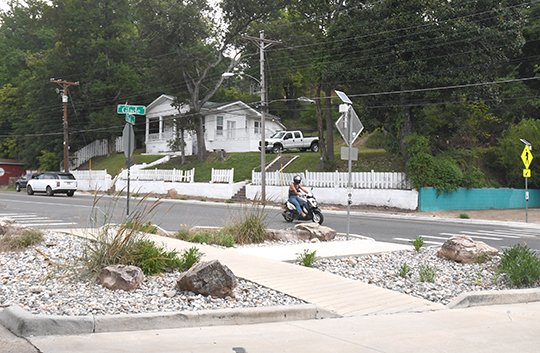Michelle Sestili, who has served as the city's Community Development Block Grant administrator since 2013, recently discussed past successes and the future of the CDBG program.
Sestili, who is moving to Houston with her husband, Max, reflected on the nearly $2 million in improvements to infrastructure, neighborhood revitalization, economic development, increases in affordable housing and compliance with federal regulations accomplished during her tenure.
"The Hot Springs program has greatly benefited from Michelle's tireless efforts to encourage citizen participation in bettering its CDBG program," Assistant City Manager/City Clerk Lance Spicer said in a news release.
Sestili told The Sentinel-Record a popular and "very visible" project has been the rain gardens, and noted the first one came about when stormwater personnel were installing a storm siren on Whittington Avenue. "They tore up the street to put the siren in and thought, 'Why put asphalt back?' That little corner flooded a lot, so they put in a rain garden."
She said she did an environmental review of Park Avenue and discovered parts were in a flood plain, where HUD requires taking mitigating measures. They were already building bump-out curbs to narrow crossing distances. "That is an overly wide street and with elderly and disabled crossing you want them to have the shortest distance across," she said, noting they combined the curbs with rain gardens.
CDBG funds built the curbs, stormwater personnel built the rain garden layers and the Park Avenue Community Association worked with the Hot Springs Parks and Trails Department to install the plants. They also installed decorative boulders that prevent cars from getting on sidewalks. "Yeah, they look nice, but they're really there to protect you. People fly through there and have a habit of not staying on the road," she said.
Sestili said her personal favorite project was installing new playground equipment at Chattanooga Park. "It was just such a visual difference. It looks so nice now. The old equipment was metal and dingy. Now it's bright primary colors and makes the whole playground more cheery and it's not going to cut you or burn you or get rusty."
They also installed some playground equipment in the city's other parks and replaced old wooden picnic tables with newer "vandalism resistant" ones, added bathrooms at Baseball Trail Park and acquired a "landlocked lot" to expand Linden Park.
They plan to add another park in some vacant lots on Pleasant Street behind the Hot Springs Police Department and put in a basketball court "and maybe some other things. We are waiting on a landscape architectural plan. The police can have pick up games with the neighborhood kids," she said.
Federal funding for CDBG projects will be lower this year, however. Sestili said a bill placed before Congress prior to the Aug. 1 recess included $500 million less funding for the grant program, which "sounds like a lot, but when spread across everything the impact is not going to be massive. Will it be less? Yes. Will it be devastating? No."
She also noted Congress has not reconvened yet to discuss the bill "so we don't know what will happen."
Sestili said when she first took the job she had to create a five-year plan, which involved a 900-page document detailing community development needs, housing and economic analysis, homelessness needs, "basically a giant 'What's going on in our community?' document" from which they then chose their high-level goals for the next five years.
She said the city will have to prepare another five-year plan due at the end of 2018 and the CDBG goals may change and "focus on other things" with the next plan.
"Overall, I am very proud of our neighborhoods and the city. We've come a long way in four and a half years working together. The quality of projects and the collaboration can't be beat. I have nothing but good things to say about the city. I have never met any horned devils and most people were so nice to me and wanted to help," she said.
Hot Springs hosted the Arkansas Community Development Association's spring meeting last year and took CDBG administrators from all over the state on a bus tour of the projects here and "they were floored," Sestili said.
"We talked about how our different departments and neighborhoods worked together and how the neighborhoods pick their own projects and they were absolutely blown away," she said.
"It's not always how it's done, but it works for us. I've toured some projects in other cities, beautiful projects, but we do more with less here. I'm very excited to see where things go."
Local on 09/06/2017